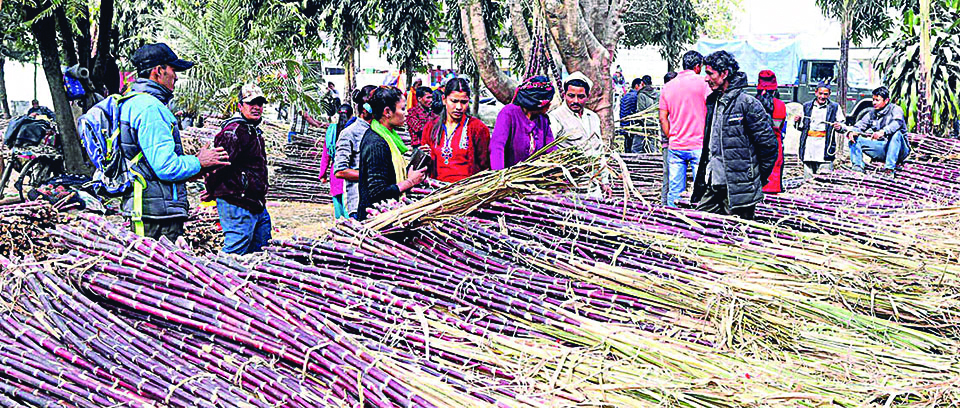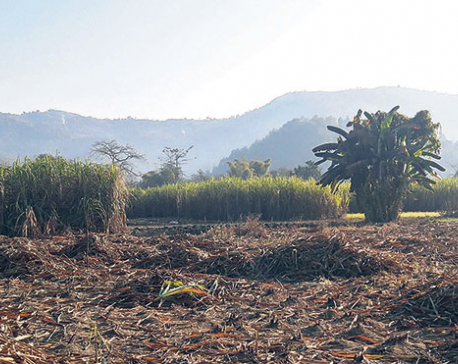
OR


Paras Kharel
The author is a Research Director at South Asia Watch on Trade, Economics and Environment, Kathmandunews@myrepublica.com
The case for sheltering sugar mills behind a quota, or a tariff, wall in order to safeguard the livelihoods of sugarcane farmers rests on shaky grounds
When Prime Minister K P Sharma Oli reportedly instructed his ministers and bureaucrats to stop sugar imports, he did not bother to dwell on how a decision to that effect would sit with economics, and international trade rules. For a person who is candid about his disdain for formal education, that was perhaps natural.
But when the finance minister, an economist by training who has the prime minister’s ears, says that the 100,000 MT quota on sugar imports, introduced in mid-September, is compatible with the rules set by the World Trade Organization (WTO) and will help in ensuring payments by sugar mills to sugarcane farmers, you should be worried.
Know the rules
Nepal’s obligations on account of its membership of the global trade rules-setting body bar it from restricting imports through quotas under normal circumstances. It can, of course, raise tariffs up to the maximum level (“bound” rates in trade terminology), negotiated when acceding to the WTO in 2004. Tariffs are another way of limiting imports. The government had hiked the same on sugar from 15 percent to 30 percent in April. Nepal has the policy space to go all the way up to 60 percent, the bound rate inscribed in its WTO schedule of commitments. Why it did not choose to do so is puzzling. After all, sugar mill owners had indicated, as per media reports, they could settle for a 50 percent tariff.
The government has hit the tariff ceiling for imports of one type of sugar, though. Under the Agreement on South Asian Free Trade Area, it has pledged to cut tariffs on imports of beet sugar (Harmonized System Code 17011200, as recorded by customs) from SAARC member states to 0-5 percent. Nepal imported 3.08 billion rupees worth (or, 68,920 MT) of this product in the first 11 months of the last fiscal year, with Pakistan supplying 2.8 billion rupees worth of it (or, 63,860 MT), subject to a six percent duty. That still leaves ample room for raising tariffs on product-source combinations accounting for about 70 percent of imports, in value as well as volume terms—among major product categories, represented by six HS Codes.
As basic international trade theory tells us, if imports have to be restricted in a market where domestic producers have some monopolistic power, quotas are an inefficient cousin of tariffs. When it comes to domestic production, the dozen-odd sugar mills in the country are collectively a monopoly. Quotas are a second-best instrument because once the stipulated amount is exhausted, domestic producers can collude to jack up prices to cater to the rest of the market demand. While tariffs go to government coffers, rents from a quota flow into the pockets of those lobbying for it, unless the government takes specific measures to extract them for itself.
Then there is the question of how the quota is allocated across importers and over time. Barely a few days after the quota decision, the government explained that the quota for this year had already been used up. The quantity of sugar imported in the first two months of the current fiscal year (mid-July to mid-September), just preceding the quota announcement, was no more than 12,000 MT. If the government is alluding to the import of 193,000-plus MT of sugar (HS Codes 17011200 and 17011490) in the previous fiscal year, the quota would appear to have been exhausted. That would be a disingenuous interpretation, making the quota declaration a fig leaf for an import ban.
Consult the caveats
If the government believes Nepal is being flooded with subsidized sugar imports, it is entitled, as per WTO rules, to impose countervailing duties, over and above the bound rate, provided—and this is crucial—it can formally establish, through a credible investigation, that the imports are causing “adverse effects” to the country. Even then, quantitative restrictions are not permitted. Similar is the case when responding to dumping. The government might argue that the issue is not just about subsidized or dumped imports and that the sharp rise in sugar imports—over four-fold in value terms and nearly six-fold in volume terms in the first 11 months of fiscal year 2017/18 compared to the full 12 months of 2016/17—warrants “emergency actions” because the increase causes or threatens to cause “serious injury” to the domestic sugar industry. If so, it can slap quantitative restrictions or raise duties above the bound rate.
But, alas, there are conditions. One of them is that the government should be able to transparently determine, through an investigation, that serious injury has taken place or there is a threat thereof. If the government wants to fast-track the process, it could appeal to the window of “critical” circumstances necessitating provisional measures that can be taken pronto. However, even here, the catch is—there is always a catch in the real world, if not for those in the high chairs of Singha Durbar—that such provisional measures, which cannot be in place for more than 200 days, may be in the form of tariff increases only. What’s more, Nepal may be called upon to pay compensation to the supplying countries whose trade is affected.
Yes, the government can impose quantitative restrictions if it faces a balance-of-payments (BoP) crisis. As a former central bank governor, the minister is well-versed in what constitutes a BoP crisis. Certainly not the importation of 12 billion rupees worth of sugar in the last fiscal year—even when adopting a liberal definition to include all imports in HS headings 1701 and 1702. Contrast these imports with 29.4 billion rupees worth of paddy and rice imports, and nearly 22.7 billion rupees worth of vegetable imports in the same period.
Transparency wanted
The case for sheltering sugar mills behind a quota, or a tariff, wall in order to safeguard the livelihoods of sugarcane farmers who have not received payments of some two billion rupees from the mill owners (as per media reports) rests on shaky grounds. Significant arrears remained even after the doubling of tariffs on sugar imports. Farmers not receiving payments on time has been a recurring problem. And we are not even touching upon a stark facet of the market facing sugarcane farmers: a monopsony, where mills can get away with offering cane prices below what they can afford to pay.
Some media reports intimate that a study by the Ministry of Industry, Commerce and Supplies on the conditions of the domestic sugar market informed the quota decision. The study is not available in the public domain. Consumers coughing up 20 to 30 percent more for sugar, or consuming less of it due to the price hike in the wake of the quota imposition, deserve to know its contents. In any case, jovial interactions with sugar mill owners and casual inspection tours do not make for an independent investigation that, inter alia, produces credible estimates of production costs. A broad spectrum of interested parties, including consumers, must be consulted. WTO rules require this. Even if they did not, a functioning democracy would.
kharelparas@yahoo.com
You May Like This
_20231224133024.jpg)
Illegally imported sugar and tobacco seized
UDAYAPUR, Dec 24: Udayapur police have confiscated a significant quantity of sugar and tobacco during an attempted illegal import. A... Read More...

Shree Ram Sugar Mills trying to bypass govt’s 5-day deadline to pay farmers
RAUTAHAT, Oct 13: Shree Ram Sugar Mills Limited of Garuda, Rautahat has started meetings with cane farmers to buy time... Read More...

Sugar price increases by a third
Supply will be normal in festive season, prices will be stabilized by Salt Trading shops: Government officials. ... Read More...







Just In
- NRB to provide collateral-free loans to foreign employment seekers
- NEB to publish Grade 12 results next week
- Body handover begins; Relatives remain dissatisfied with insurance, compensation amount
- NC defers its plan to join Koshi govt
- NRB to review microfinance loan interest rate
- 134 dead in floods and landslides since onset of monsoon this year
- Mahakali Irrigation Project sees only 22 percent physical progress in 18 years
- Singapore now holds world's most powerful passport; Nepal stays at 98th











Leave A Comment